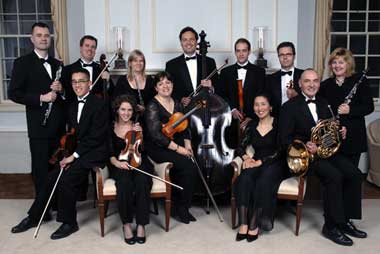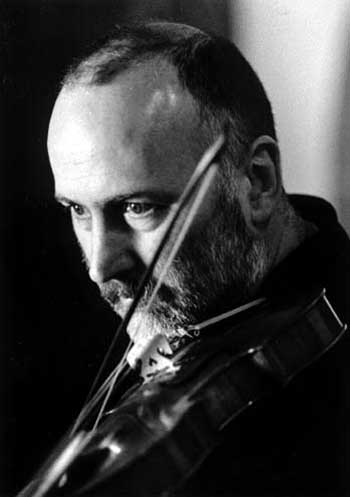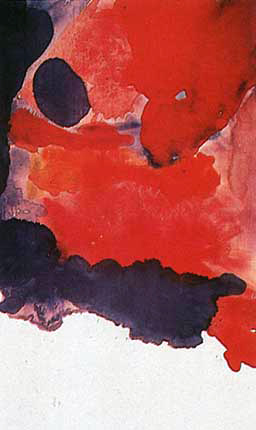Zakir Hussain at Lisner Auditorium
By Stephen Brookes • The Washington Post • April 26, 2008
_____________________________________________________________________________
The tabla virtuoso Zakir Hussain has been pushing the limits of his instrument for most of the last 57 years, since he started playing with his father, the legendary Ustad Allarakha, as a child. Steeped in the 2,000-year-old tradition of Indian classical music, Hussain has performed with masters like Ravi Shankar and Ali Akbar Khan. But he has also brought Indian percussion into the emerging genre of world music, working with such distinctly non-Indian artists as John McLaughlin (with whom he founded Shakti), George Harrison, Tito Puente and the Hong Kong Philharmonic Orchestra.

Susana MillmanHussain brought that same spirit of adventure to Lisner Auditorium on Thursday for an evening of music that spanned ancient ragas and modern approaches. And throughout, it was almost intoxicating in its intensity. His virtuosity is barely to be believed: Spinning out long, complex improvisations, Hussain played with almost infinite detail, his hands moving like precisely controlled explosions across the drums. And the range of sounds he conjured was nearly symphonic, from squabbling couples to the rich, deep bellow of a conch shell. But it wasn't a mere display of technique: Behind every note was an almost ecstatic sense of involvement.
While Hussain's playing dominated the evening, he was joined by nearly a dozen other musicians, including his two brothers, who brought some fine and unusual playing of their own. Dilshad Khan was deeply powerful on the bowed, short-necked lute called the sarangi, while the young sitarist Niladri Kumar, who's been making a name in fusion music, contributed imaginative solos on the electric sitar he calls the "zitar."
The Meitei Pung Cholom Performing Troupe, a trio of dancing drummers from Manipur, jumped around athletically in colorful costumes; it was enjoyable enough but felt a bit like something cooked up for tourists at the Imphal Hilton. Some of the most intriguing playing of the evening came from the Uzbekistan drummer Abbos Kosimov, who carved out rich, kaleidoscopic music using only the traditional tambourine-like drum called the doyra.
The Fessenden Ensemble at St. Paul's
By Stephen Brookes • The Washington Post • April 22, 2008
_________________________________________________________________________
 The Great Hall of St. Paul's Rock Creek Church is surrounded by a graveyard: a good setting for music that delves into murder, revenge and the darker corners of the human heart. So perhaps it was appropriate that the Fessenden Ensemble, one of Washington's most consistently interesting chamber groups, presented a program there on Sunday that focused on Samuel Barber's dark, blood-drenched "Medea," Op. 23, "Cave of the Heart."
The Great Hall of St. Paul's Rock Creek Church is surrounded by a graveyard: a good setting for music that delves into murder, revenge and the darker corners of the human heart. So perhaps it was appropriate that the Fessenden Ensemble, one of Washington's most consistently interesting chamber groups, presented a program there on Sunday that focused on Samuel Barber's dark, blood-drenched "Medea," Op. 23, "Cave of the Heart."
The work is not a literal retelling of the Greek myth, in which the sorceress Medea kills her own children to punish her unfaithful husband. Rather, it's a psychological portrayal of ordinary people caught, as Barber puts it, "in the nets of jealousy and destructive love." It's a gripping work, shifting restlessly between a serene surface and the dark, unsettling currents that surge underneath, and it seethes with a frightening amount of rage. But conductor Anna Binneweg took a rather clinical approach to the score, producing an efficient reading that was admirably clear but lacked a compelling sense of the inner turmoil.
More satisfying (and approachable) were the two other works on the all-Barber program. "Serenade for Strings," Op. 1, from 1929 (written when the composer was just 19), is a heartfelt and shamelessly romantic work, youthful in spirit but impressively sophisticated, and it got a fine reading from the ensemble's string players. Richer pleasures, though, were to be found in Barber's "Summer Music," Op. 31, for woodwind quintet. Written with the lightness and evanescent beauty of a dream, it's a luminous, enchanting piece that received a beautifully calibrated performance by the Fessenden players
Sonny Rollins at the Kennedy Center
By Stephen Brookes • The Washington Post • April 20, 2008
___________________________________________________________________________

Concord RecordsThe crowd at a sold-out Kennedy Center Concert Hall rose cheering to its feet on Friday night when Sonny Rollins took the stage, and it was a fitting tribute. At 77, Rollins is still the reigning god of the tenor saxophone, one of jazz's most innovative and influential pioneers.
And despite the inevitable declines of age (he moves with awkward stiffness now) and the weight of being the country's elder statesman of cool (check out those impenetrable shades), Rollins proved that he's still a volcano of fierce inventiveness and raw, urgent power.
From the first notes of "Sonny, Please," which opened the set, Rollins brought a restless edge to his playing, free-ranging his way through solos that erupted with ideas. He plays with a vast palette of sound, developing themes with expressive color as much as sheer power, and there's an urgent, almost primal quality to his playing that makes it riveting. And while Rollins has lost a few fans for his forays into Caribbean and pop-inflected music in recent years, there was nothing glib about the calypso-flavored "Nice Lady" that followed -- intensely personal, it swooped and probed and plunged across his entire range, like some wild bird suddenly uncaged.
Rollins displayed more sides of his playing throughout the evening, from the tender phrasing in Duke Ellington's "In a Sentimental Mood" to the fierce unaccompanied cadenza in Noel Coward's "Someday I'll Find You," which brought down the house. "Global Warming" revealed an introspective side, and the evening closed with the electrifying "Why Was I Born."
While Rollins's five-piece band provided solid support, the wattage tended to dim whenever Rollins himself wasn't playing. Dampened by muddy amplification, guitarist Bobby Broom turned in agreeable but meandering solos for most of the night. Trombonist Clifton Anderson (Rollins's nephew) was the most consistently interesting player, developing minimal motifs into imaginatively worked-out solos that never failed to surprise, and percussionist Kimati Dinizulu, manning an array of African instruments, turned in a stunning solo on "Global Warming."
Intoxication
 "According to the thinkers of the East, there are five different intoxications: of beauty, youth and strength; then the intoxication of wealth; the third is power, command, the power of ruling; and there is the fourth intoxication, which is the intoxication of learning, of knowledge. But all these four intoxications fade away just like stars before the sun in the presence of the intoxication of music. The reason is that it touches that deepest part of man’s being. Music reaches farther than any other impression from the external world can reach. And the beauty of music is that it is both the source of creation and the means of absorbing it. In other words, by music was the world created, and by music it is withdrawn again into the source which has created it."
"According to the thinkers of the East, there are five different intoxications: of beauty, youth and strength; then the intoxication of wealth; the third is power, command, the power of ruling; and there is the fourth intoxication, which is the intoxication of learning, of knowledge. But all these four intoxications fade away just like stars before the sun in the presence of the intoxication of music. The reason is that it touches that deepest part of man’s being. Music reaches farther than any other impression from the external world can reach. And the beauty of music is that it is both the source of creation and the means of absorbing it. In other words, by music was the world created, and by music it is withdrawn again into the source which has created it."
Hazrat Inayat Khan (1882-1927)
Holloway/Linden/Mortensen Trio at the Library of Congress
By Stephen Brookes • The Washington Post • April 19, 2008
____________________________________________________________________________

John HollowayThe Library of Congress has hosted several of the ferocious young ensembles -- including Ensemble Matheus and the Venice Baroque Orchestra -- that have lately been shaking the dust off 18th-century music with electrifying, foot-stomping performances. And God bless 'em: Vivaldi and co. needed the adrenaline desperately. But it was equally satisfying to step back and take a breath on Thursday, when three of the finest early music specialists on the scene alighted at Coolidge Auditorium to present a quieter and more intimate -- but no less involving -- take on the baroque.
British violinist John Holloway, Dutch cellist Jaap ter Linden and Danish harpsichordist Lars Ulrik Mortensen make a formidable team, especially when exploring some of the less-trampled paths of the baroque. Relying less on power than on finely honed delicacy and wit, they turned their flavorful, astringent sound to good advantage in a program that included some unusual surprises. A sonata by the little-known Francesco Maria Veracini burned with dark imagination, and a trio by Boismortier -- famous mostly for his unflagging glibness -- was full of inventive, forward-looking rhythms and intriguing turns. Who knew?
The ensemble work was superb throughout, with violinist Holloway's thoughtful, clear-eyed intensity leading the way, particularly in Corelli's Sonata in E Minor, Op. 5, No. 8 -- an exercise in undiluted beauty, as far as these ears could make out. Ter Linden, whose playing is playful even at its most serious, delivered a breathtaking account of Vivaldi's Sonata No. 7 in G Minor, RV 42, for cello, while Mortensen -- dancing rapturously with his harpsichord throughout the evening -- brought off Couperin's ineffable "Les Barricades Mistérieuses" as if it were made of pure light.
The Altenberg Trio at Dumbarton Oaks
By Stephen Brookes • The Washington Post • April 16, 2008
_______________________________________________________________________________
Full-time time piano trios are something of a rarity, so it's been a treat to have a stream of them rolling through town in recent weeks. First came the hip, adventurous Amelia Piano Trio (whose violinist sported a tattoo with her evening gown), followed by the venerable Beaux Arts Trio, which bowed from the scene this month with a sublime farewell performance at the Library of Congress. And on Sunday the Vienna-based Altenberg Trio, a fine ensemble with a rising reputation, arrived at the newly renovated music room at Dumbarton Oaks.
The Altenberg TrioNo one will mistake the Altenbergs -- violinist Amiram Ganz, cellist Alexander Gebert and pianist Claus-Christian Schuster -- for wild-eyed revolutionaries; decked out in white tie and tails, they stuck largely to the middle of the middle, playing with formality and restrained correctness. Things got off to a slow start with Beethoven's Variations on "Ich bin der Schneider Kakadu," a work that requires a certain, shall we say, forbearance. Built on a vacuous aria by Wenzel Mueller (the title translates to "I am the Tailor Cockatoo," which is all you need to know), it flirts constantly with insipidity and needs a committed performance to keep it honest. But the Altenberg didn't really try to sell it, turning in a tame, well-mannered account with all the edgy vitality of wallpaper paste.
There was more to sink your brain cells into when the trio returned for Robert Schumann's fascinating Trio No. 3 in G Minor, Op. 110. It's a remarkable work, written in 1851 when Schumann was in decline with mental illness. But there's nothing deranged about the piece. It may sound as if Schumann is slowly tearing open his own heart, but he does it with logic and seething power. And yet, while Ganz (who seemed to be on autopilot during the Beethoven) turned in an often vivid account, the performance felt more professional than personal; Schumann at a cool remove, which is hardly Schumann at all.
The ensemble finally locked onto target in Dmitri Shostakovich's masterly Piano Trio No. 2 in E Minor, Op. 67, which may be one of the most compelling trios in the repertoire. Written in memory of a friend, Ivan Sollertinsky, who died suddenly in 1944, it is an anguished and shockingly intense work, and the trio played it with insightful, precisely controlled fury. From the plaintive opening to the unbearably delicate close -- which left the audience in silence for several long moments -- the Altenbergs showed that, when they tried, they could be nothing short of stunning.
21st Century Consort: Fields of Color
By Stephen Brookes • The Washington Post • April 8, 2008
___________________________________________________________________________
Helen Frankenthaler, Blue AtmosphereFor much of the last four decades, the 21st Century Consort has presented concerts that link the work of modern visual artists to that of contemporary composers. In its final concert of the 2007-08 season at the Smithsonian American Art Museum on Saturday, the group took on the work of American painters like Helen Frankenthaler and Jules Olitski, presenting some lively and intriguing new work that played off the museum's current exhibit "Color as Field: American Painting, 1950-1975."
But the obvious period suspects -- composer Morton Feldman jumps to mind -- were nowhere to be heard. Nearly all the works were written in the last few years, and while marquee composers Libby Larsen and Charles Wuorinen were represented, the focus was on less famous names. David Froom's "Lightscapes" was an involving study in contrasts for flute and piano, and Evan Chambers's "Rothko-Tobey Continuum" blended a luminous, wistful violin line, deeply evocative of Rothko, with a recorded track that echoed Mark Tobey's hieroglyphic canvases. Played by Elisabeth Adkins with her usual thoughtful poise, it was lyrical and -- considering it was partially written (er, "generated") by a computer -- undeniably poignant.
The real weight of the concert, though, came in two contrasting works: James Primosch's brooding "Dark the Star" and Bruce MacCombie's "Color and Time." Built around poems by Susan Stewart and Rainer Maria Rilke, "Dark the Star" is a low-voiced journey through shadows, suffused with night and death, and received a suitably uncompromising performance from baritone William Sharp. By contrast, the MacCombie work was filled with delicate light and subtle washes of color. Perhaps the most purely enjoyable work of the afternoon, it was sung with deft precision by the Cantate Chamber Singers, under the direction of Gisèle Becker.

